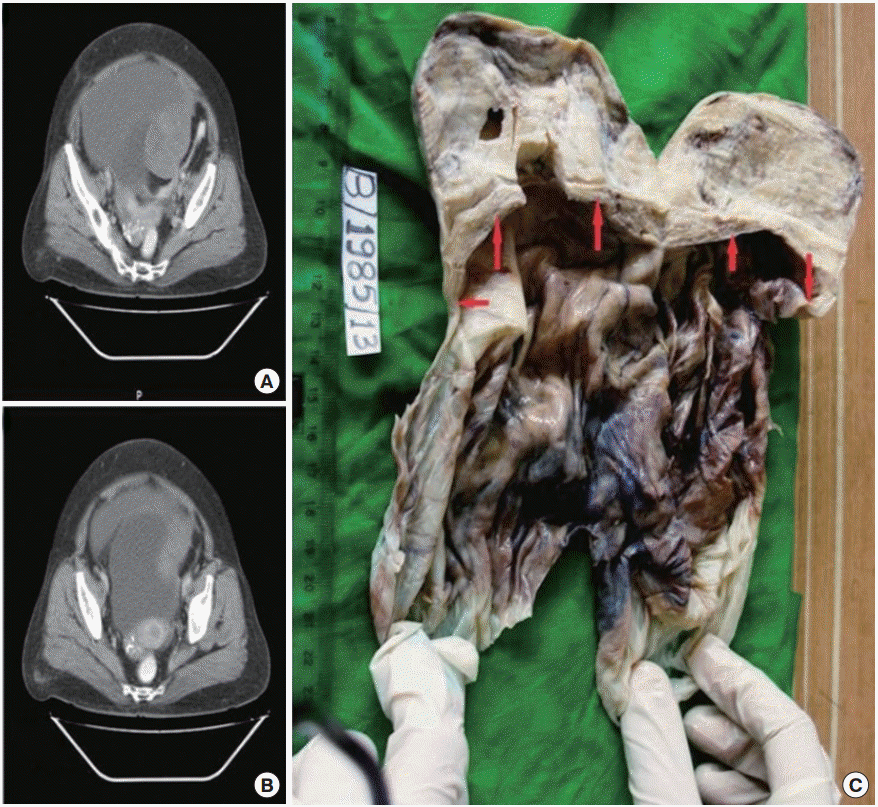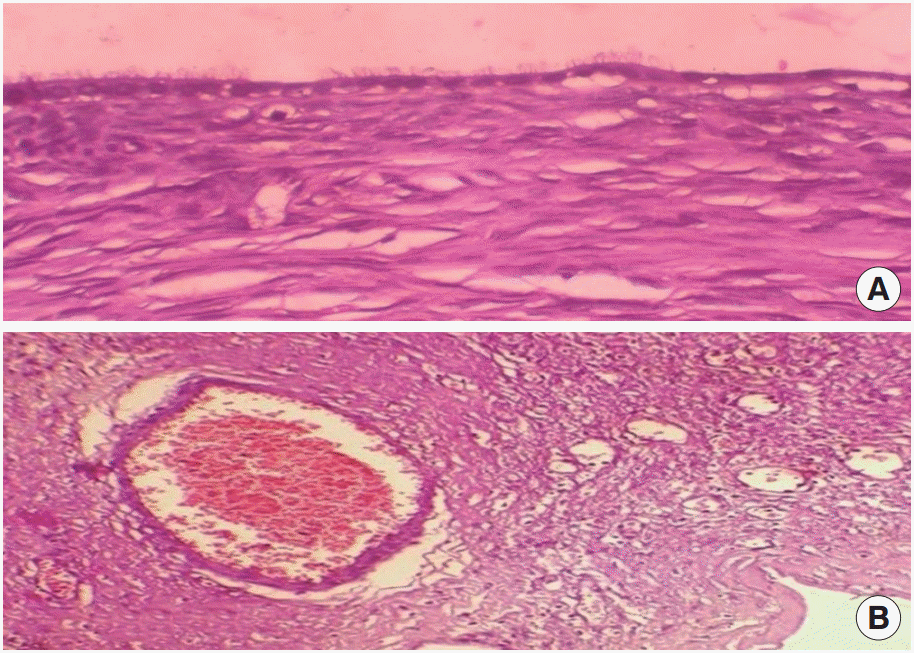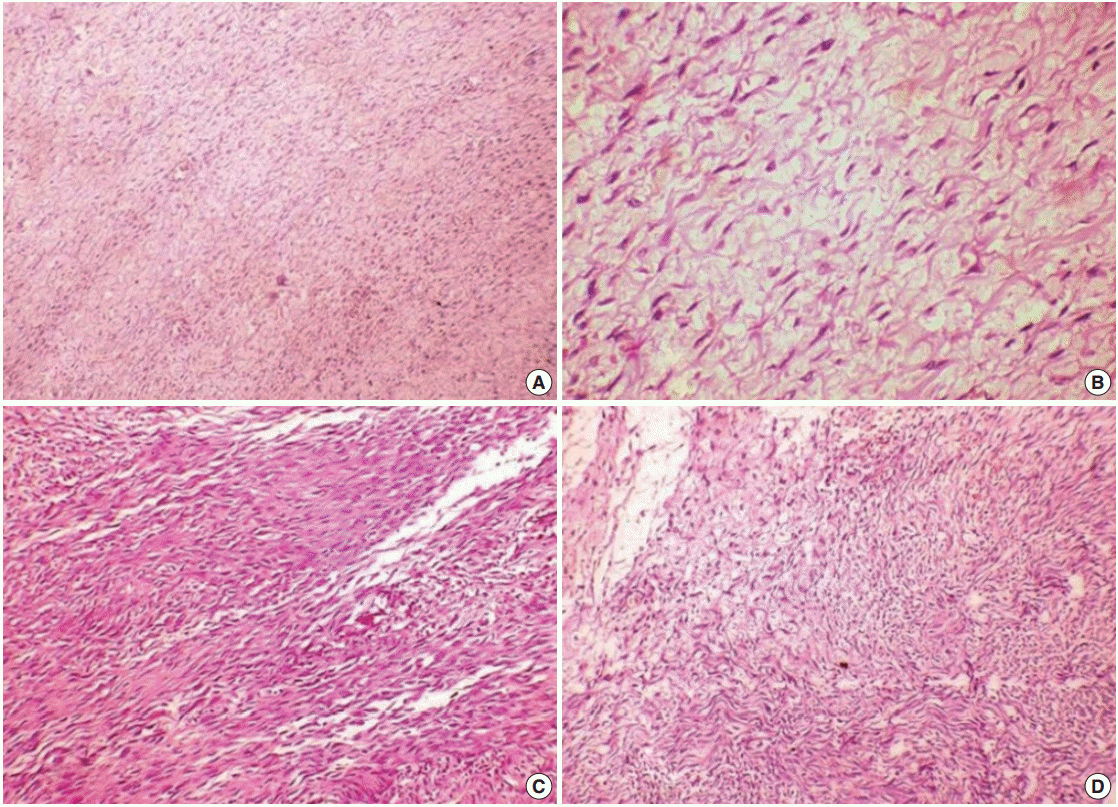Articles
- Page Path
- HOME > J Pathol Transl Med > Volume 49(2); 2015 > Article
-
Brief Case Report
Serous Cystadenoma and Fibrothecoma: A Rare Combination in Collision Tumor of Ovary with Pseudo-Meigs Syndrome - Shirish S. Chandanwale, Sukanya S. Pal, Harsh B. Kumar, Amit B. Sammi
-
Journal of Pathology and Translational Medicine 2015;49(2):163-166.
DOI: https://doi.org/10.4132/jptm.2013.11.25
Published online: March 12, 2015
Department of Pathology, Dr. D. Y. Patil Medical College, Pimpri, India
- Corresponding Author: Shirish S. Chandanwale, M.D. 75/1+2/1, Krishna Appt, Behind Indraprastha BLD, New Sangvi, Pune, Maharashtra 411027, India Tel: +98-90144517, Fax: +98-020-27805217, E-mail: shirishchandanwale@gmail.com
• Received: September 26, 2013 • Revised: November 17, 2013 • Accepted: November 25, 2013
© 2015 The Korean Society of Pathologists/The Korean Society for Cytopathology
This is an Open Access article distributed under the terms of the Creative Commons Attribution Non-Commercial License (http://creativecommons.org/licenses/by-nc/3.0/) which permits unrestricted noncommercial use, distribution, and reproduction in any medium, provided the original work is properly cited.
- A 63-year-old, parous, menopausal woman was admitted with complaints of abdominal distention for 3 months and difficulty in passing urine for 1 month. Physical examination revealed an abdominal lump and ultrasonography revealed a large cystic mass. A computed tomography (CT) scan revealed a large cystic lesion (22.7×15×20 cm) occupying the pelvis and abdomen, with a well delineated solid area (9×5 cm) within it. Minimal ascites were noted (Fig. 1A, B). No other significant findings, including pleural or pericardial effusion, were noted. Malignant neoplasm of the ovary was suspected.
- Cytology of ascitic fluid showed a few reactive mesothelial cells. Malignant cells were not seen. Carcinoma antigen 125 (CA-125) levels were mildly elevated (0.42 IU/mL). A specimen from radical hysterectomy, including a left ovarian cystic mass, was received for histopathological examination.
- On cutting, the left ovarian cyst leaked blood-tinged, serous fluid. The cut surface showed a large, uniloculated, thin walled cyst (20×18 cm) with a smooth surface and congested vessels. At one end of the cyst, we observed a well-demarcated, solid, homogeneous, yellow-white mass (8×6 cm) (Fig. 1C, arrows). A few areas of cystic changes were seen. Compressed ovarian tissue at the periphery and fallopian tube could be identified.
- Histopathological examination of the solid area in the left ovarian mass showed a tumor composed of fascicles of loosely arranged spindle cells with variable cellularity and a variable amount of intervening collagen. The cells had oval to elongate nuclei with a moderate amount of pale to vacuolated cytoplasm (Fig. 2A, B). Nuclear atypia, mitotic activity, and edema were not seen in the tumor tissue. In places, closely packed spindle stromal cells were arranged in fascicles and a storiform pattern with hyaline collagen bands (Fig. 2C, D). No glandular structures were seen. A diagnosis of fibrothecoma was made.
- Histopathological examination of the cyst showed a fibrocollagenous wall lined in places by cuboidal epithelium with cilia (Fig. 3A). Papillae were not seen. A diagnosis of serous cystadenoma was made. Sections from the junction of the two tumors showed normal ovarian stromal tissue with congested blood vessels (Fig. 3B). A final histological diagnosis of an ovarian collision tumor consisting of fibrothecoma and serous cystadenoma was made.
CASE REPORT
- Collision tumors are defined as two adjacent but histologically distinct tumors, without admixture, in the same tissue or organ [1]. These tumors are rare clinical entities.
- The majority of these tumors are a collision between carcinomas and sarcomas or lymphomas and have been reported in various organs. Collision tumors involving ovaries are extremely rare. Many hypotheses have been put forward to explain the rare phenomenon of collision tumors: coincidental occurrence; carcinogenic agents of a primary tumor; oncogenic growth factors produced by a metastatic tumor; and alterations in the microenvironment [1]. In this case, the finding was coincidental. Very few reports of collision tumors involving ovaries have been reported in the literature [1,3,4].
- The pathology of collision tumors reveal two different types of coexisting neoplastic tissues, with a sharp demarcation between the two and without a substantial admixture of histology at the interface. The most common combination of collision tumor in the ovary involves teratoma with mucinous tumors (cystadenoma and carcinoma) [1].
- Thecoma and fibroma often merge, therefore the term fibrothecoma is appropriate. Pure thecomas are typically associated with estrogenic manifestations, which were not seen in our case. Ovarian fibrothecomas often clinically present as a solid adnexal mass and can mimic malignant ovarian tumors.
- Ultrasonography features of fibrothecoma are usually nonspecific, and magnetic resonance imaging (MRI) is often needed for further differentiation from other solid ovarian masses [5]. MRI was not done in our case. Ovarian fibromas and fibrothecomas can be associated with ascites, sometimes in combination with pleural effusion, which may lead to a mistaken impression of inoperable ovarian neoplasm [5].
- In 1937, Meigs described seven cases of combined pleural effusion, ascites, and ovarian fibroma and named it Meigs syndrome [6]. In 1954, he limited the syndrome to cases where tumor removal cures the disease [6]. Pseudo-Meigs is a variant, not possessing the original tumor cell types described by Meigs [7].
- Proposed mechanisms for the ascites in Meigs syndrome are production of ascitic fluid by the tumor; lymphatic obstruction; hormonal stimulation; release of inflammatory mediators; and tumor torsion. Pleural effusion is thought to be caused by the migration of fluid and protein—perhaps by lymphatic channels— across the diaphragm [6]. In the present case, pleural effusion was not present, which was possibly due to the minimal amount of ascitic fluid. Elevated serum CA-125 levels, which are seen in Meigs or atypical Meigs syndrome, were seen in this case [8].
- To the best of our knowledge, we are presenting the first case in the English literature of collision of fibrothecoma and serous cystadenoma in an ovary with Pseudo-Meigs syndrome. For correct diagnosis, these tumors need to be differentiated from fibrothecoma with massive cystic changes and serous cystadenofibroma. The presence of cuboidal lining epithelium with cilia in the cyst wall ruled out massive cystic changes in fibrothecoma and a follicular cyst. The absence of glandular structures in fibrothecoma ruled out serous cystadenofibroma. Follow up examination of the patient postoperatively showed the disappearance of ascitic fluid on a CT scan.
- We conclude that a diagnosis of collision tumor involving an ovary is challenging and often made postoperatively. The collision of fibrothecoma and serous cystadenoma is a rare combination and can cause Meigs or Pseudo-Meigs syndrome. Elevated serum CA-125 levels alone cannot differentiate between benign and malignant ovarian masses.
DISCUSSION
Fig. 1. (A, B) Computed tomography scan showing a large cystic lesion occupying the pelvis and abdomen (solid area), and minimal ascites. (C) Specimen of left ovarian cyst with well-demarcated solid yellow tumor mass (arrows).


Fig. 2. Microscopy of solid tumor showing areas of thecoma (A, B), fibroma (C), and mixture of fibroma and thecoma (D).


Fig. 3. (A) Microscopy of cyst wall showing lining of cuboidal epithelium with cilia. (B) Microscopy from the junction of solid and cystic tumors showing congested ovarian stroma.


- 1. Bige O, Demir A, Koyuncuoglu M, Secil M, Ulukus C, Saygili U. Collision tumor: serous cystadenocarcinoma and dermoid cyst in the same ovary. Arch Gynecol Obstet 2009; 279: 767-70. ArticlePubMed
- 2. Murthaiah P, Truskinovsky AM, Shah S, Dudek AZ. Collision tumor versus multiphenotypic differentiation: a case of carcinoma with features of colonic and lung primary tumors. Anticancer Res 2009; 29: 1495-7. ArticlePubMed
- 3. Papaziogas B, Souparis A, Grigoriou M, et al. A rare triple coexistence of a collision tumor, a benign mature cystic teratoma and a hemorrhagic follicular cyst of the ovaries. Internet J Surg 2008; 14: 19-24. Article
- 4. Moid FY, Jones RV. Granulosa cell tumor and mucinous cystadenoma arising in a mature cystic teratoma of the ovary: a unique case report and review of literature. Ann Diagn Pathol 2004; 8: 96-101. ArticlePubMed
- 5. Kitajima K, Kaji Y, Sugimura K. Usual and unusual MRI findings of ovarian fibroma: correlation with pathologic findings. Magn Reson Med Sci 2008; 7: 43-8. ArticlePubMed
- 6. Thaker DA, Stride PJ, Dettrick A. A pseudo case of atypical pseudoMeigs syndrome. Indian J Cancer 2011; 48: 364-6. ArticlePubMed
- 7. Kazanov L, Ander DS, Enriquez E, Jaggi FM. Pseudo-Meigs’ syndrome. Am J Emerg Med 1998; 16: 404-5. ArticlePubMed
- 8. Renaud MC, Plante M, Roy M. Ovarian thecoma associated with a large quantity of ascites and elevated serum CA 125 and CA 15-3. J Obstet Gynaecol Can 2002; 24: 963-5. ArticlePubMed
REFERENCES
Figure & Data
References
Citations
Citations to this article as recorded by 

- Pseudo-Meigs syndrome due to bilateral serous ovarian adenocarcinoma: A case report
T. Semina, S. Kannangara, S. Silva
SAGE Open Medical Case Reports.2024;[Epub] CrossRef - Case report: Highly differentiated endometrial adenocarcinoma that collided with uterine cervical carcinosarcoma
Xue Fan, Haoyue Hu, Yang Liu, Songtao Tan, Meng Xie, Fang Zhang
Frontiers in Medicine.2023;[Epub] CrossRef - A case report of bilateral benign Ovarian Fibrothecoma coincidental with ascites: an unconventional co-occurrence
Raied Mohamad, Omar Al Laham, Reham Albrijawy, Mostafa Sallom, Alhasan Merhij, Mohammad Almousa
Annals of Medicine & Surgery.2023; 85(7): 3739. CrossRef - Ultrasound Findings andO‐RADSMalignancy Risk Stratification of Ovarian Collision Tumors
Yuyang Guo, Shan Zhou, Baihua Zhao, Lieming Wen, Minghui Liu
Journal of Ultrasound in Medicine.2022; 41(9): 2325. CrossRef - A Rare Case of Collision Tumours of the Ovary: An Ovarian Serous Cystadenoma Coexisting with Fibrothecoma
Michele Mongelli, Erica Silvestris, Vera Loizzi, Gennaro Cormio, Gerardo Cazzato, Francesca Arezzo
Diagnostics.2022; 12(11): 2840. CrossRef - A Rare Case of Pseudo-Meigs' Syndrome With Ovarian Metastasis Presenting as Meigs' Syndrome
Nimit Dalal, Pal Satyajit Singh Athwal, Biswaraj Tharu, Lakshmi Saravanan, Hassan Mansour
Cureus.2020;[Epub] CrossRef - Collision Tumors in Ovary: Case Series and Literature Review
Borges A, Loddo A, Martins A, Peiretti M, Fanni D, Djokovic D
Journal of Surgical Oncology.2019; : 1. CrossRef - Combined ovarian serous cystadenoma and thecoma
Mudiwa Muronda, Peter Russell
Pathology.2018; 50(3): 367. CrossRef - Collision Signet-Ring Stromal Tumor and Steroid Cell Tumor of the Ovary: Report of the First Case
Stephanie M. McGregor, J. Kenneth Schoolmeester, Ricardo R. Lastra
International Journal of Gynecological Pathology.2017; 36(3): 261. CrossRef
 PubReader
PubReader ePub Link
ePub Link-
 Cite this Article
Cite this Article
- Cite this Article
-
- Close
- Download Citation
- Close
- Figure
Serous Cystadenoma and Fibrothecoma: A Rare Combination in Collision Tumor of Ovary with Pseudo-Meigs Syndrome



Fig. 1. (A, B) Computed tomography scan showing a large cystic lesion occupying the pelvis and abdomen (solid area), and minimal ascites. (C) Specimen of left ovarian cyst with well-demarcated solid yellow tumor mass (arrows).
Fig. 2. Microscopy of solid tumor showing areas of thecoma (A, B), fibroma (C), and mixture of fibroma and thecoma (D).
Fig. 3. (A) Microscopy of cyst wall showing lining of cuboidal epithelium with cilia. (B) Microscopy from the junction of solid and cystic tumors showing congested ovarian stroma.
Fig. 1.
Fig. 2.
Fig. 3.
Serous Cystadenoma and Fibrothecoma: A Rare Combination in Collision Tumor of Ovary with Pseudo-Meigs Syndrome

 E-submission
E-submission





